Plant Profiles dive deep on one plant variety each month. They are meant to provide you with enough information to make good growing decisions. A desire to grow gorgeous flowers is one thing. However, discerning if a particular plant is right for you and your climate is a whole other ballgame.
My intention here is to give you as much practical information to make these decisions. However, I’m going one step further and taking you completely behind the scenes to share exactly what has worked for us as well. For this reason, Plant Profiles are broken up into what I’m calling the “Nuts and Bolts (N&B)” and “Behind the Scenes (BTS).”
If you haven’t already, please be sure to read the FFY Introduction to learn more about how Plant Profiles are organized.
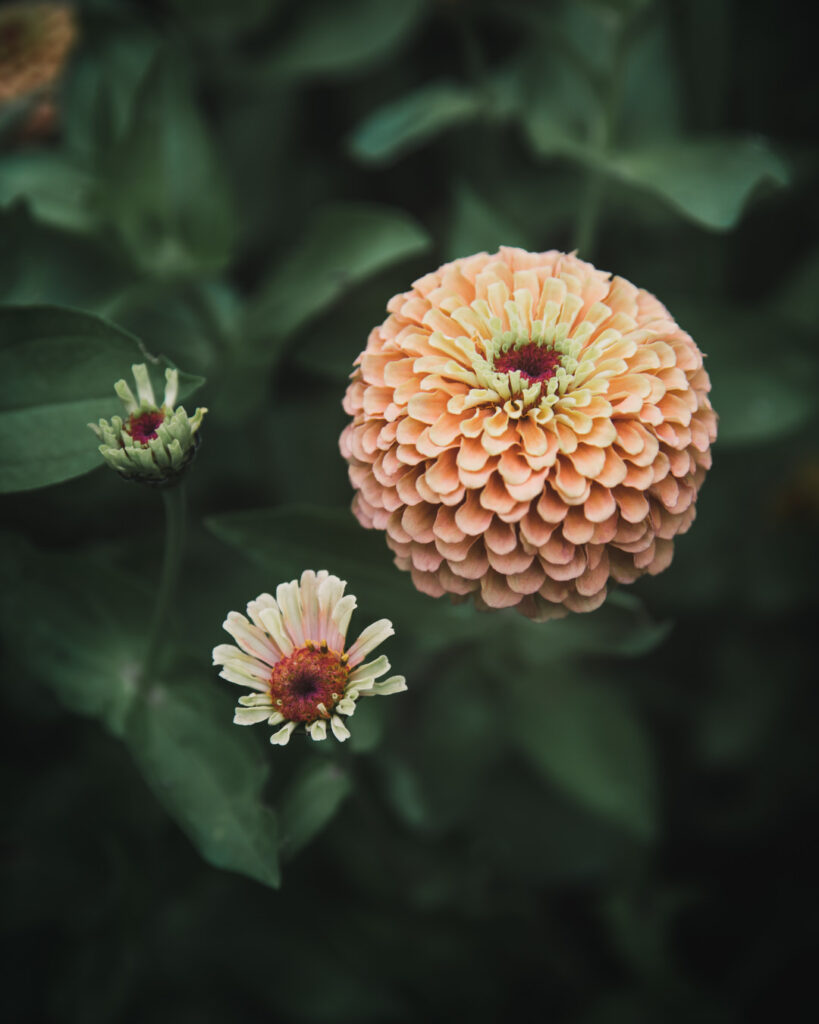
Primary Sources
The primary sources for the N&B portion come from:
- Postharvest Handling of Cut Flowers and Greens: A Practical Guide for Commercial Growers, Wholesalers & Retailers (Dole, Stamps, Carlson, et al).
- Specialty Cut Flowers, 2nd Edition, Revised & Enlarged (SCF): Industry standard for both new and experienced growers on the production of annuals, perennials, bulbs, and woody plants for fresh and dried cut flowers (Allan M. Amritage and Judy M. Laushman)
- Johnny’s Selected Seeds (Johnny’s): Johnny’s has been in the business for 50 years, with a research farm dedicated to finding the best seeds and tools for farmers and gardeners
- Zinnia Cut Flower Production in Utah (Tiffany Maughan, Melanie Stock, and Maegen Lewis). Horticulture. Utah State University.
Zone Considerations
- Johnny’s Selected Seeds research farm is located in Zone 5a Maine
- USU Trials were conducted at Greenville Farms, Zone 5 Utah and USU Botanical Center, Zone 6 Utah
- My farm, Petal Back Farm, is located in Zone 4b Wisconsin
General Information: N&B
- Latin Name Name: Zinnia spp.
- Common Name: Zinnia
- Origin: Americas
- Days to Maturity: 75–90 days (depending on variety)
- Life Cycle: Annual
- Spacing: 9–12′
- Height: 30-50″
Zinnias are one of the most popular and easiest cut flowers for the flower farm. They have a wide range of colors, shapes, and sizes. As a native to the Americas, they are relatively heat and drought tolerant. Other qualities include sturdy stems, good yield, disease resistance, and vase life.
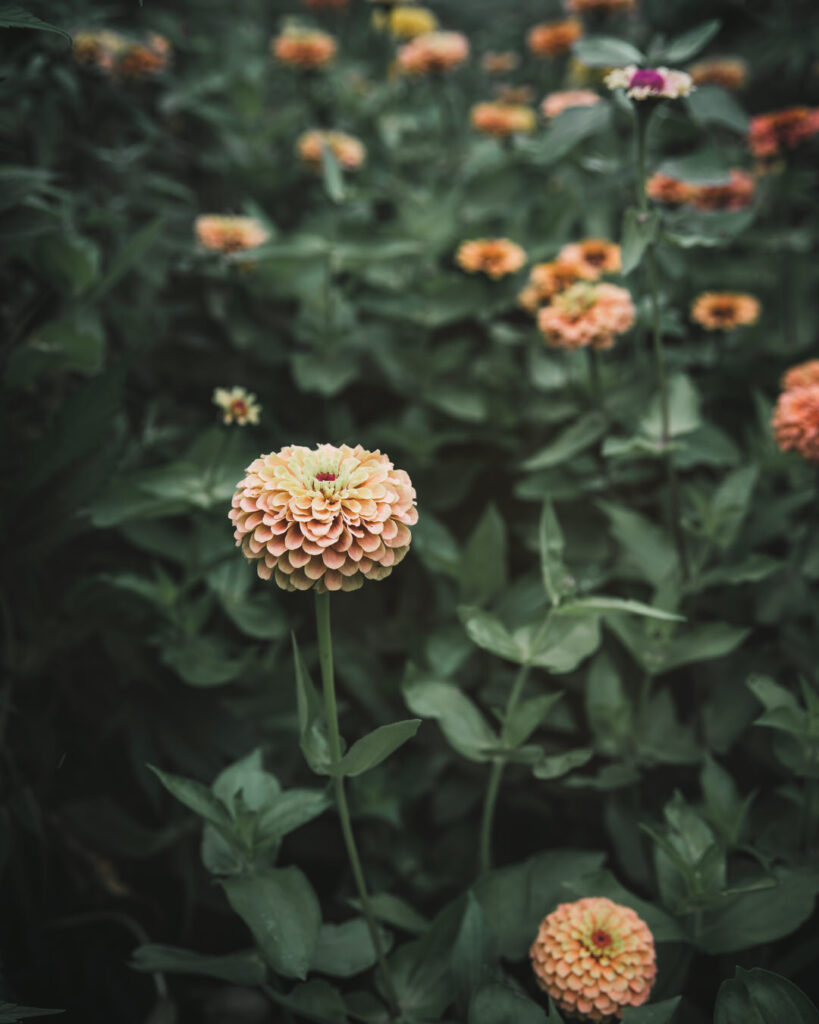
General Information: BTS
I couldn’t leave zinnias out of FFY, because they are considered a staple for the cut flower farmer. They’re productive, fast growing, relatively low maintenance, and come in a wide range of colors. What’s not to love?
Well, I’ll tell you what! No, I’m only half kidding, but I do kinda have a love-hate relationship with zinnias.
Well, hate is too strong of a word, it’s more like a love-meh relationship. The reason I feel “meh” about them is that even though they are a low-maintenance, reliable flower, they are not my go-to for market bouquets or retail. It’s not that I don’t use them, I do, but I find only a fraction of them are useable *for me.*
Zinnias are super (I mean, super) common in my area, so I just don’t feel like they have enough of a “wow” factor for my customers unless they’re really primo, like my best Benary’s Giant Salmon or Queen Series (if you grow zinnias, you likely know what I’m saying, some are a lot better than others). For this reason, I find that I end up not using many and they’re really more to fill/bridge color (or make the pollinators happy, ha).
And while I think some are really cool, others are just dog ugly or even if they’re form is nice, I honestly find a lot of them to be quite gaudy. However, I am super interested in all of the amazing breeding going on by Floret, Blomma Farm, Dawn Creek Farm.
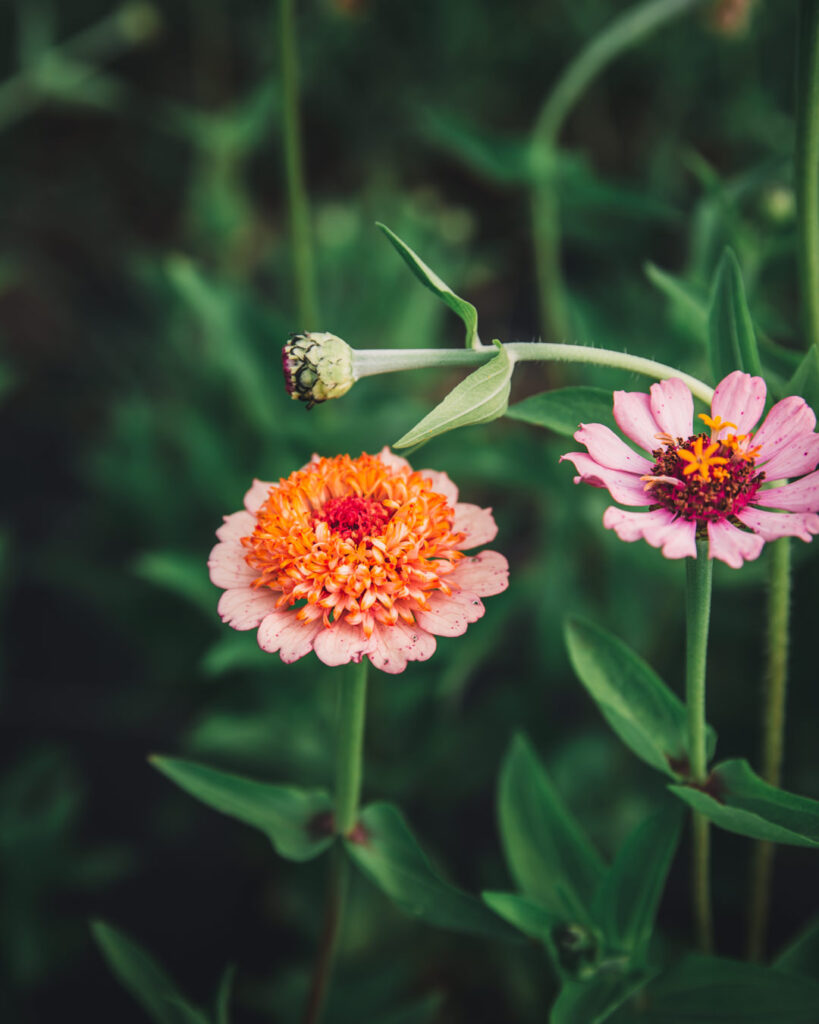
All that said, I *love* zinnias . . . for design. That might sound kind of odd after what I just said, but they are a great bridge flower due to their colors (meaning they often have a combination of colors that blend separate colors of one flower to the next). They’re great support flowers, and I feel like I can spend a little more time picking out the perfect ones (and sometimes, these are the funky ones I’d be worried my retail customers would find ugly LOL).
Whereas I worry zinnias will be “meh” for my customers when they open up a market bouquet (this might just be my insecurity), I think done right in design, they can be really beautiful in an unexpected, but intentional “beauty found in the imperfection” kind of way (Gabriela Salazar is a master at this, like here, here, and here). They add a charming vibe for certain.
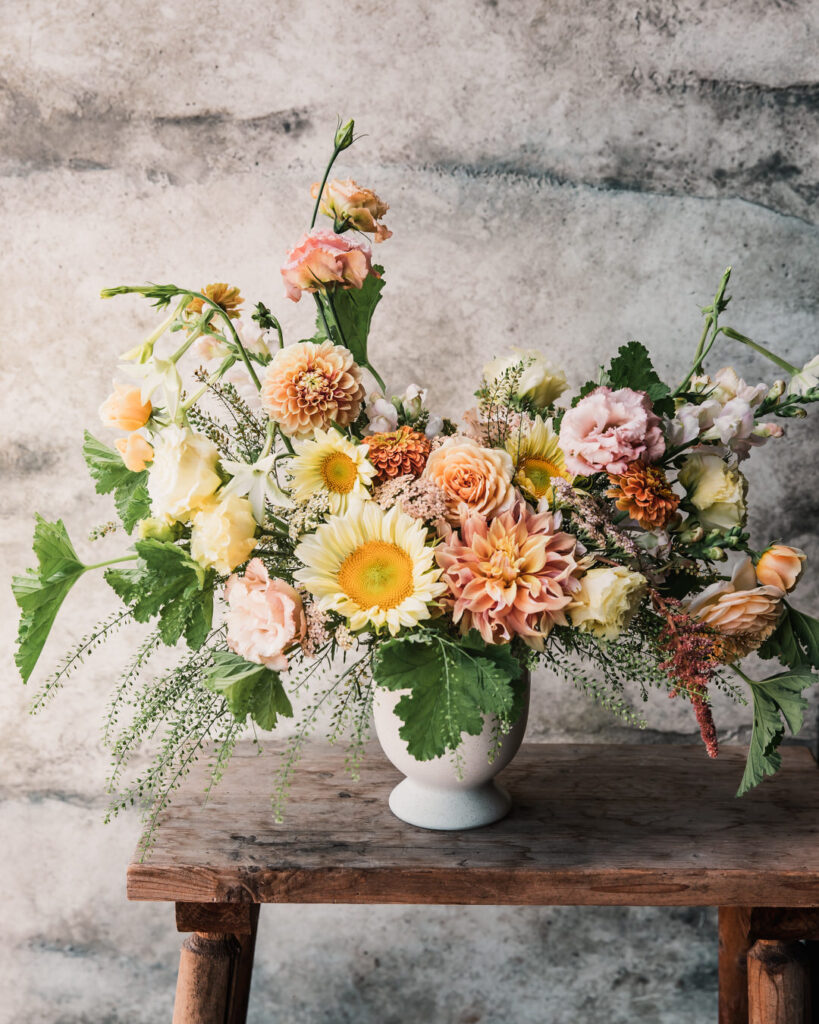
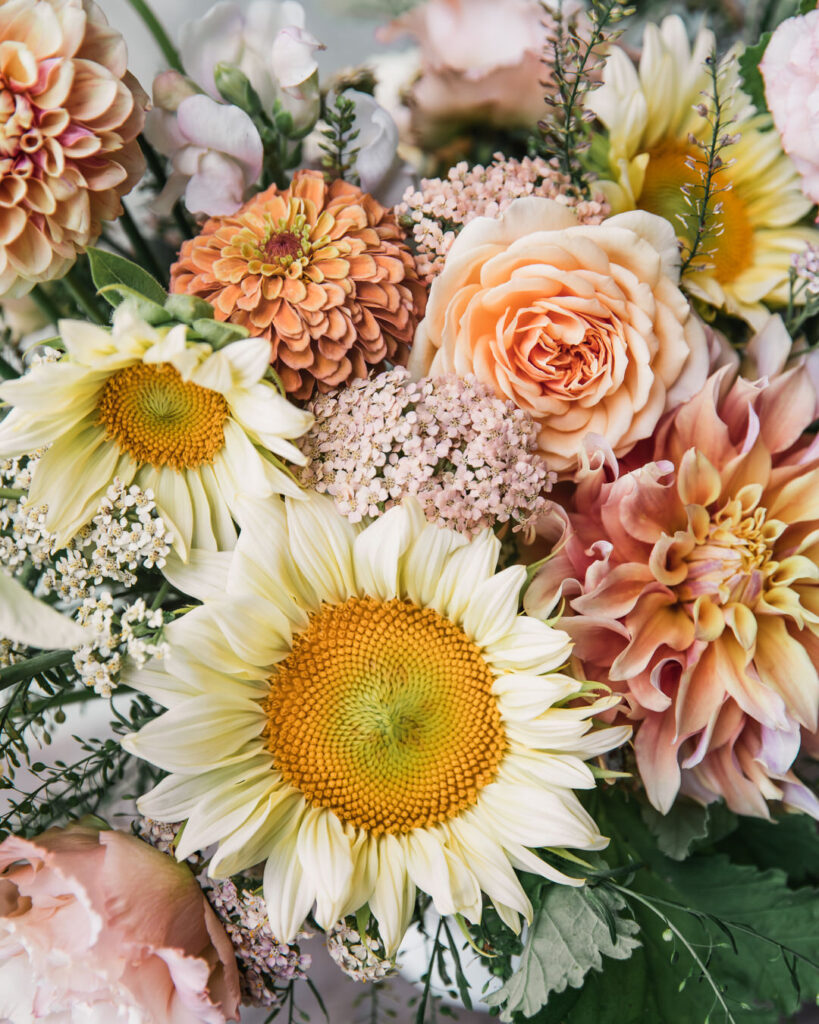
Is that weird? What do you think: Am I being too hard on zinnias for market?
Also, please don’t let my opinion sway you. MANY growers are super successful with zinnias in their market. USU notes zinnia sales at farmer’s markets are typically high and they are excellent additions to mixed bouquets.
The other reason I love zinnias is the pollinators. And yup, they really ARE so easy, it doesn’t hurt to sow some even if you don’t end up cutting many. I had a bunch of seeds that were quite a few years old (hello, seed-ordering habit), so I mixed them all together this summer and direct sowed them and they have brought me (and the pollinators) a lot of joy. I find the most joy in an en masse handful!
P.S., if I had a U-Pick or people visiting the farm, I’d plant a crazy amount of zinnias.
What I love most about zinnias as a cut flower:
- Easy to grow
- Can direct sow
- Wide range of colors (all but blue)
- Unique colors
- Range of size and forms
- Great for design
- Cheerful
- Prolific
- Resilient
- Attract pollinators
But every rose has its thorn, right? Potential shortcomings:
- In many areas, super common (customer *may* not see as much value)
- Not uniform
- No scent
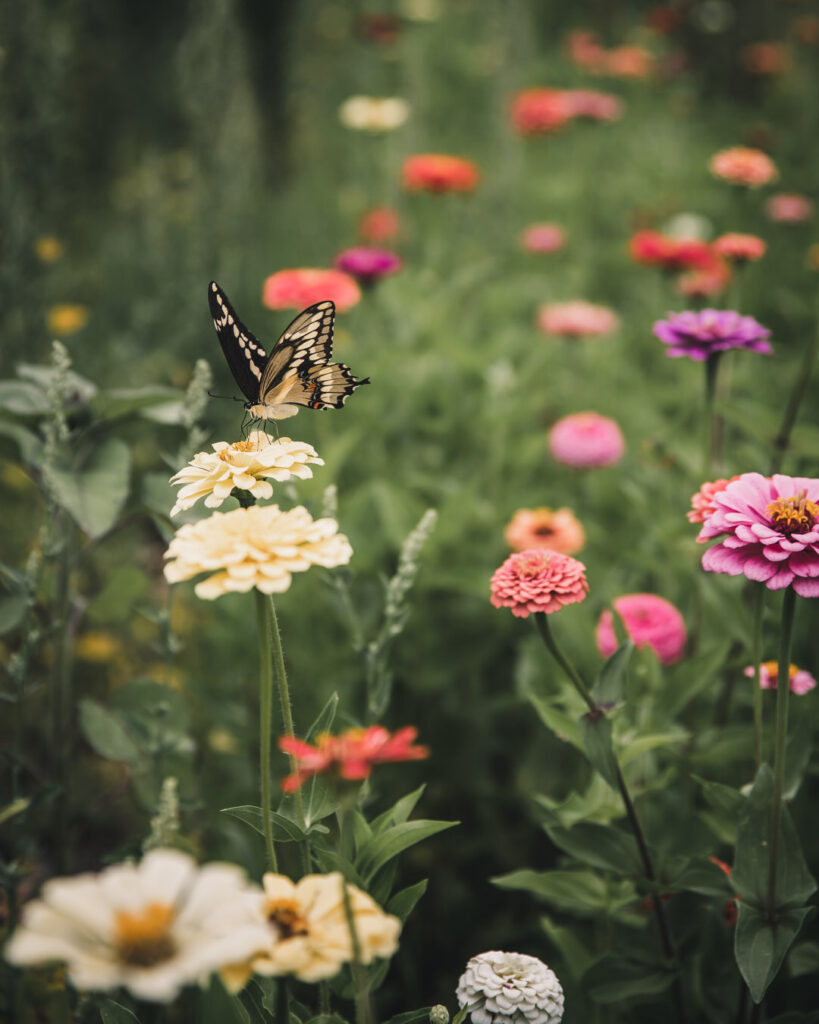
Propagation: N&B
Zinnias are propagated from seed. Most varieties are open-pollinated but there are some F1 cultivars.
Johnny’s recommends direct sowing seeds after last frost when the soil has warmed to at least 70F (21C) or for transplanting, sowing 1–2 seeds per cell into 50- or 72-cell plug trays 4 weeks before last frost. Seed germinates in 3–5 days at 80–85F (27–29C) or 5–7 days at 70–75F (21–24C) (SCF).
Propagation: BTS
We do both: direct sow after last frost and transplant.
Environmental Factors: N&B
Photoperiod
Zinnias flower more rapidly under short days but eventually flower regardless of photoperiod (day lengths of 12 hours or less stimulate flowering) (SCF).
Temperature
Zinnias prefer daytime temperatures 70F (21C) or above. Temperatures below 60F (15C) result in chlorotic foliage and delayed flowerings (SCF).
Site Selection
Zinnias can be grown either in the field or a protected structure (some grow them in a tunnel in areas where it does not get warm enough). They prefer fertile soil, rich in organic matter with a pH 6.0–6.5. If downy mildew is a problem, a location with more wind may be beneficial, though it may require additional support.
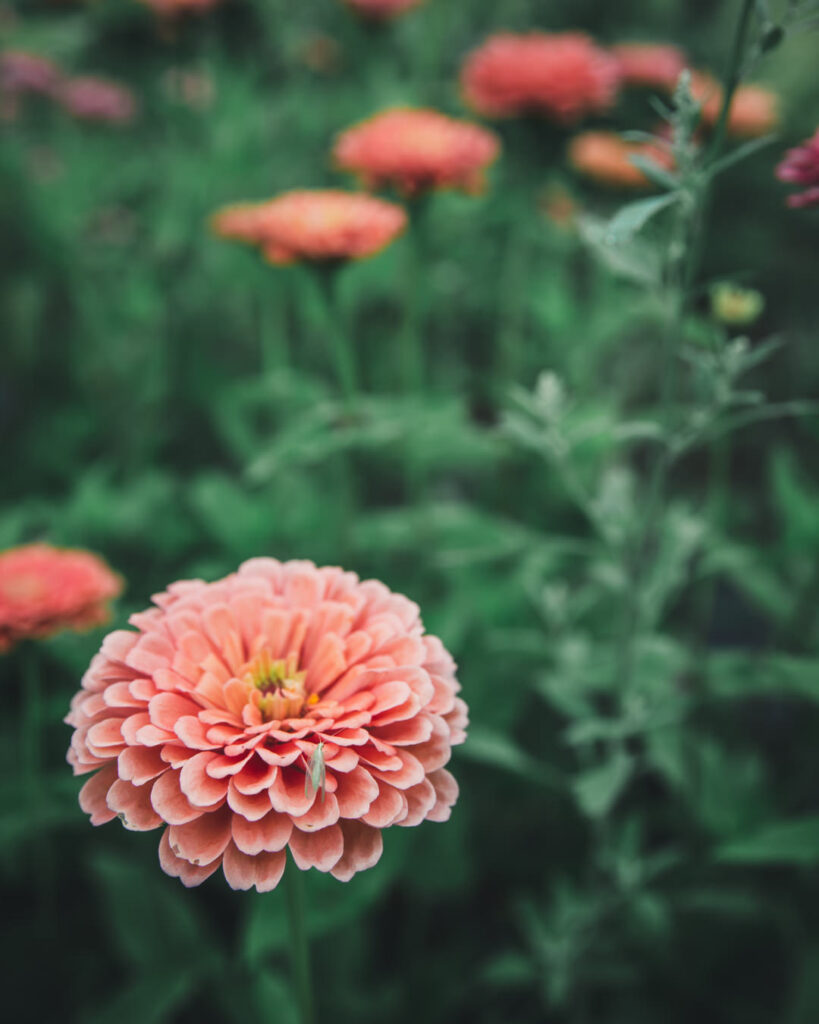
Environmental Factors: BTS
We mostly grow zinnias in the field, but I have attempted a small early crop in the tunnel for an event. I don’t know that I’d do this regularly, but they had orange in their color palette, so I was going for some Queen Lime Orange zinnias. It was a hail mary as they booked just over 2 months before their event. It did not work out, ha, but it was a nice crop for a different event 🙂
Here in the midwest, it gets plenty warm for zinnias, so they are not really worth the prime real estate in the tunnel for me. They also don’t seem to mind our extreme heat some summers.
Transplanting, Spacing, Support: N&B
If transplanting, it’s important not to let zinnias become root bound or disturb roots during transplanting. Did you know that transplant shock may cause doubles to revert to singles? Either did I, but according to Johnny’s this is a possibility. For this reason, it’s also important to harden off seedlings for at least one week.
Most sources recommend spacing plants 9–12″ on center, but closer spacing is fine so long as air circulation is sufficient. Both Johnny’s and SCF note that support is not necessary in higher latitude locations, but a later of horizontal support may be necessary to keep stems upright in some growing conditions (especially areas with high wind and rain).
Transplanting, Spacing, Support: BTS
We space our zinnias 9 inches apart on center when transplanting, though they are sometimes closer when direct sowing. We do not use support.
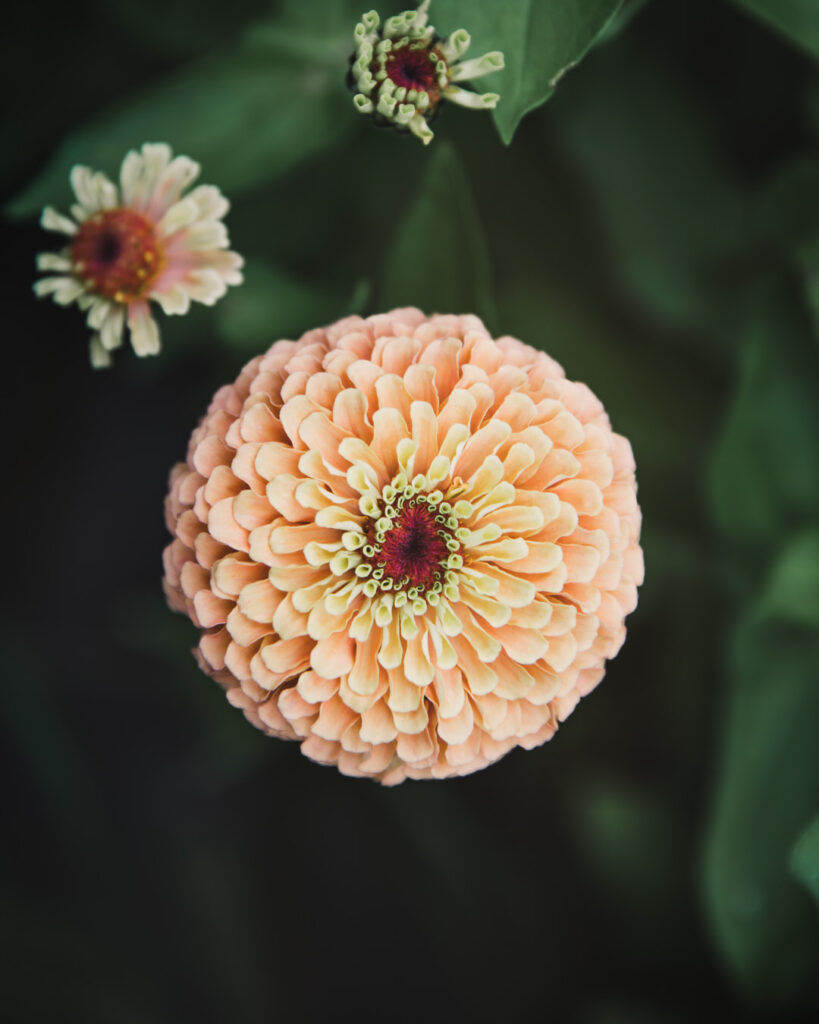
Successions: N&B
For an extended harvest and a constant supply, Johnny’s and SCF recommend succession planting every 2–3 weeks through early summer.
Successions: BTS
Here in Zone 4 Wisconsin, our season is not that long, so I only do 2–3 successions per season. Personally, I think 3 weeks between successions works great.
Nutrition: N&B
Most sources recommend amending soil based on a soil test. Additionally, SCF and Johnny’s both recommend nitrogen for zinnias. Generally, zinnias need 1.5–2 pounds nitrogen per 1,000 square feet (Johnny’s). Similarly, USU recommends 0.15 pounds of nitrogen per 100 square feet each year. For example, 0.2 pounds (scant 1/2 cup) of conventional urea fertilizer (46-0-0), or 0.8 pounds (about 2.5 cups) of organic 16-0-0 fertilizer.
Nutrition: BTS
I am sure that dialing in your fertilization game per crop is ideal, but we do not do that. We fertilize our fields organically based on soil tests, and we do not fertilize for each crop individually. I have an eBook that outlines exactly how we do this. I’ve made that available for you here.
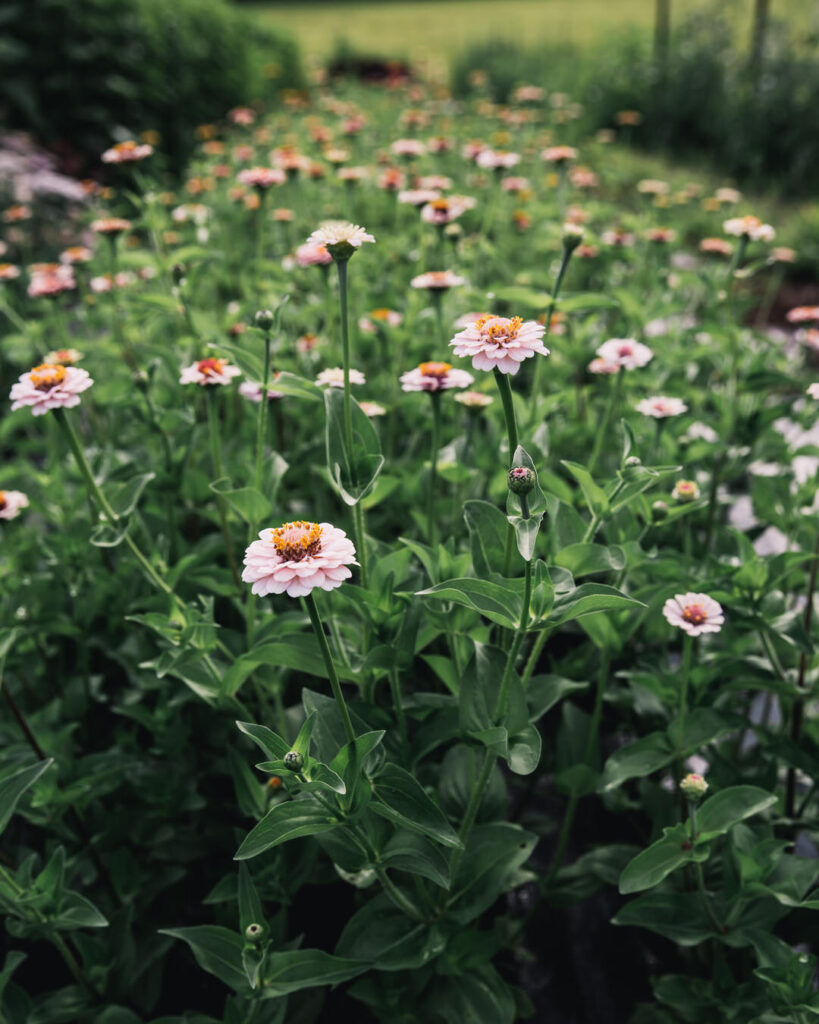
Drainage & Irrigation: N&B
Most sources recommend drip irrigation. Overhead can be used, but it does increase the chances of disease. To prevent disease, water early in the day so that the foliage is dry by nightfall. During establishment, water two to three times per week to ensure the new transplants establish well. Once established, zinnias are fairly drought-tolerant and irrigation can be reduced to one time per week. Apply 1–1.5 inches of water with each irrigation (USU).
Drainage & Irrigation: BTS
At our farm, we have gossil-loamy sand, meaning that our soil is more sand than loam. It actually drains excessively to the point of leaching nutrients. Our biggest difficulty is keep plants irrigated, especially in dry spells. For this reason, we do have drip irrigation installed on all of our beds at the home farm. That said, I did not add irrigation lines to a direct-sown bed of zinnias this season, and it’s been fine (we’ve even had periods of drought).
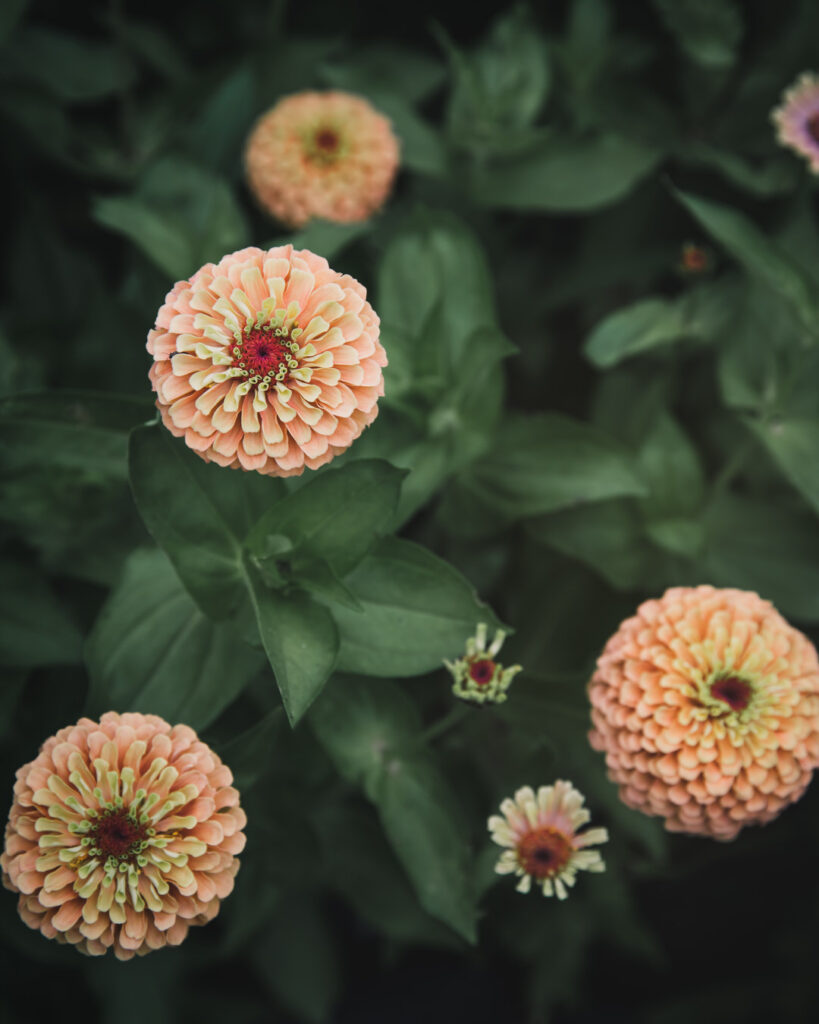
Pinching: N&B
Johnny’s and SCF notes that it’s not necessary to pinch zinnias, but that doing so will result in longer stems. If pinching, most sources recommend pinching when the plant is 8–12 inches tall by removing the top 3–4 inches of the plant just above the leaf axil.
Pinching: BTS
Sometimes I pinch, other times I don’t (mostly because they just get away from me 🙂 ).
Bloom Period: N&B
Bloom period is highly dependent on geographic location and growing environment, but in most areas zinnias bloom from early summer until temperatures drop significantly below 60F. Harvesting regularly and deadheading will encourage branching and prolong bloom period.
Bloom Period: BTS
We typically have zinnias July–September.
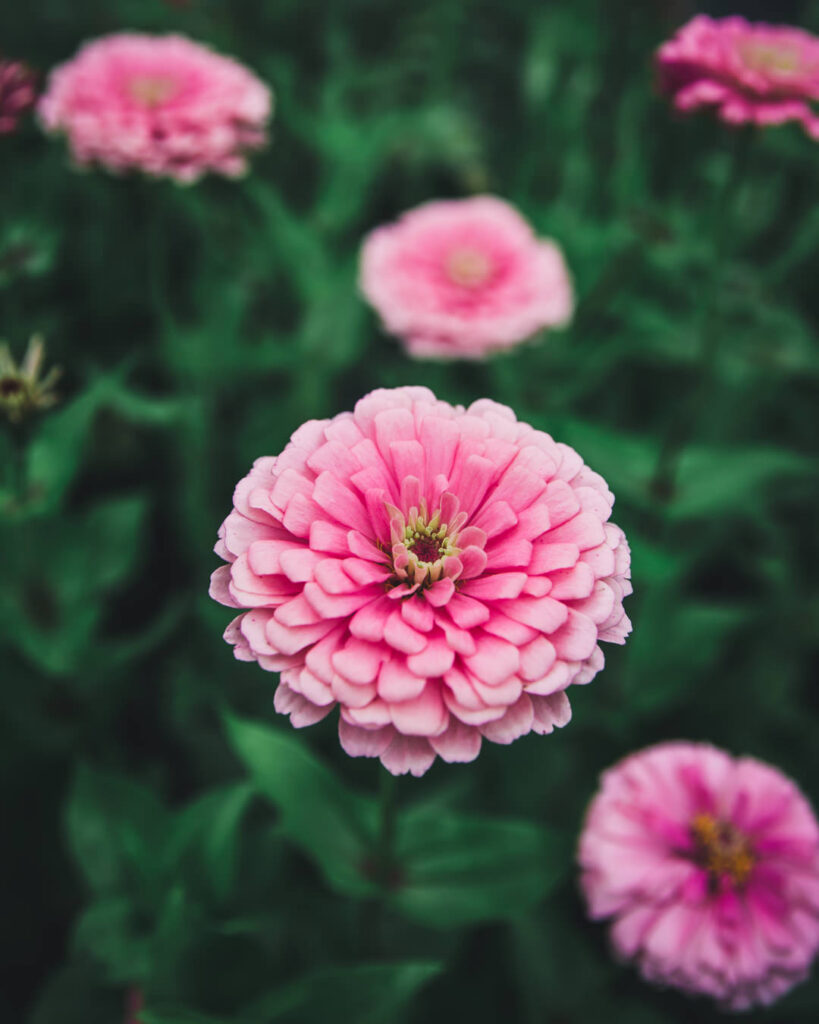
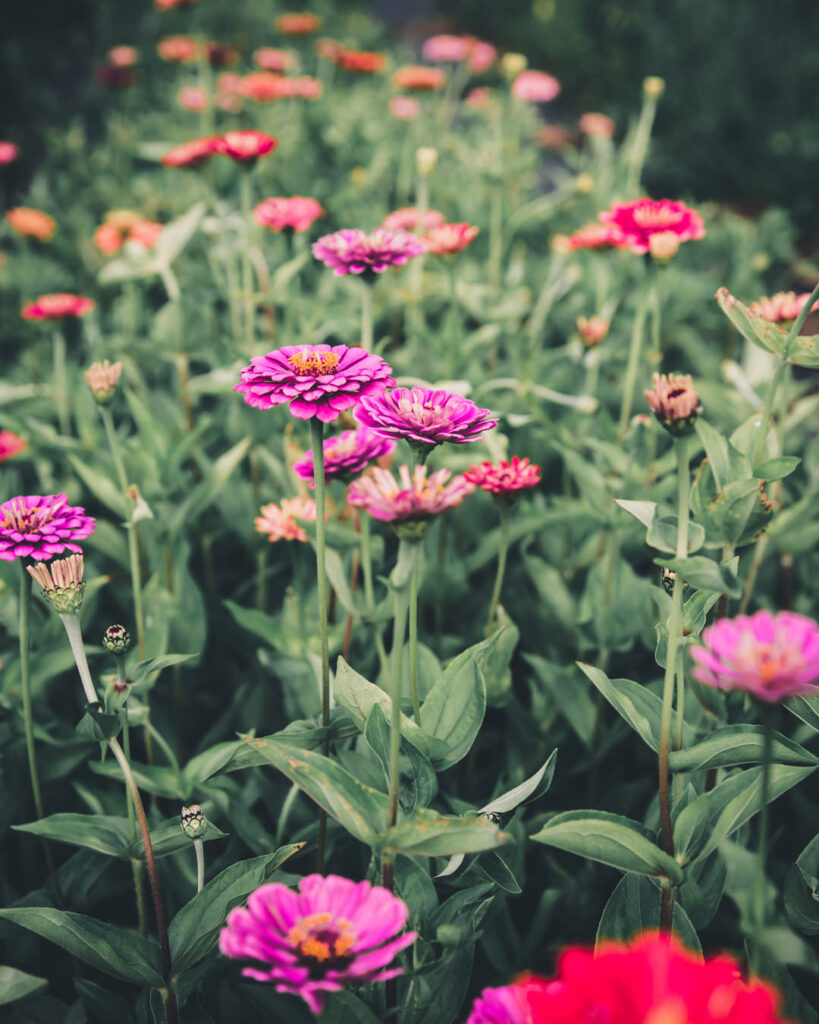
Harvest: N&B
Most sources recommend harvesting just before the blooms are completely open and when temperatures are cool. SCF also notes that when pollen is just forming is an appropriate timeframe. Cut stems as long as possible but leaving enough nodes on the plant for future production. Florist-grade stems should be at least 12 inches long with a preferred length of 18–24 inches (USU).
Harvest: BTS
I learned the “wiggle test” when visiting Sarah’s flower farm, Sweet 16 Farm. Prior to visiting her farm, I didn’t know flower farms were even a “thing.” I’ll never forget her showing us how she wiggles the zinnia stem to see if it’s ready to harvest. To do so, gently grasp about halfway down the stem and then gently shake it back and forth. If flower head is floppy, it’s not ready. If the stem is stiff and the head does not bobble, it’s ready to harvest!
Post-Harvest Treatment and Storage: N&B
Postharvest Handling reports that in NCSU trials, over a dozen zinnia cultivars have been tested, and vase life for most was 7–14 days (in fact, you can view their trials by variety here). Similarly, they note that dozens of cultivars have been evaluated in ASCFG National Seed Trials, with growers reporting average vase life of 7–8 days. Johnny’s and SCF note 5–7 days.
Postharvest Handling recommends harvesting into clean buckets. Commercial hydrators can be used immediately after harvest but should not be left for longer than a few hours. With the addition of slow-release chlorine tablets, stems can stay in the solution longer (which many growers use because zinnias are considered dirty flowers, meaning they make the water cloudy/murky). After hydration, they recommend moving to a holding solution, which will increase vase life by one to five days for most cultivars.
Zinnias should be stored for no more than one week in water and never stored dry. Experimentally, zinnias can be held for 1–2 days at 33–35F (1–2C), but longer storage results in damage. To be safe, store at 40–45F (4–7C) (Postharvest Handling).
Post-Harvest Treatment and Storage: BTS
I cut zinnias to order, only taking what I need for the week (leaving the rest for the pollinators), so I’m not really storing them. I’ve always been too worried about them being too cold in the cooler, so I’ll just leave them out in the shop area. As the season progresses and we get into dahlia season, I’ll increase the cooler temperature and then I’ll put zinnias in the cooler if needed.
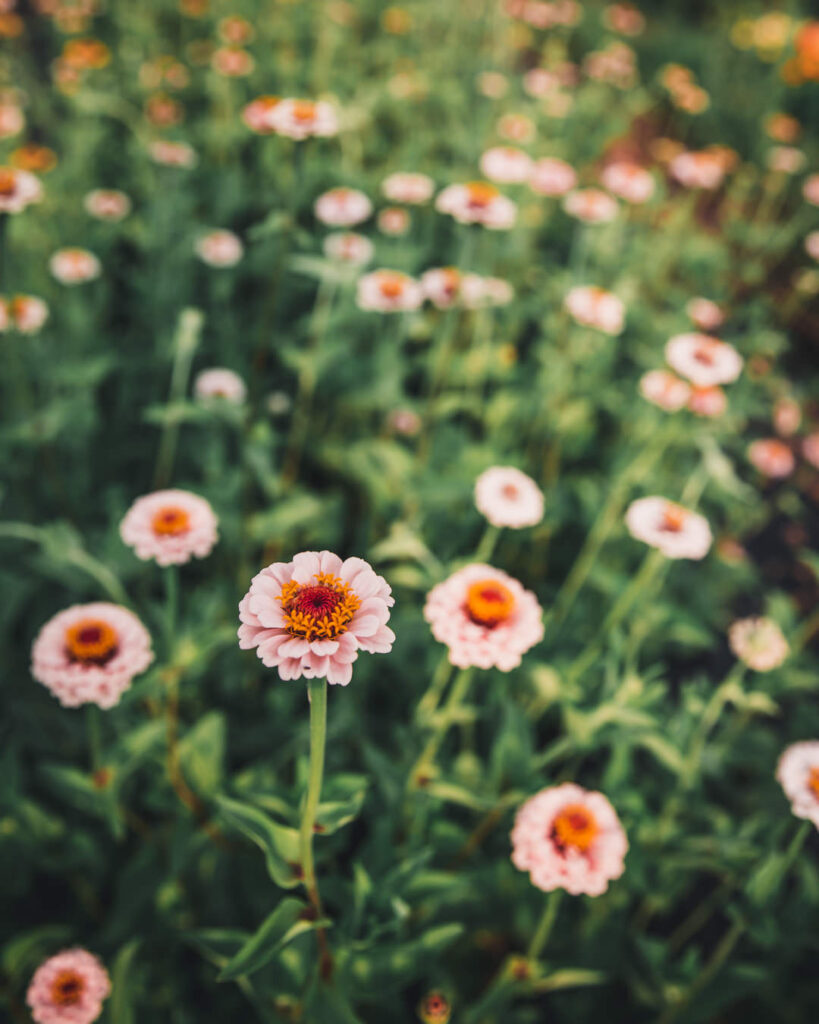
Pests & Disease: N&B
Most sources note some of the most-common diseases are powdery mildew, leaf blight/spots, fungal diseases, botrytis, root/stem/crown rots, and Tomato Spotted Wilt Virus (TSWV). SCF also mentions “zinnia meltdown” a term coined by growers to describe the rapid deterioration (within 24 hours) of perfectly good-looking flowers after being cut. Stems turn brown and mushy. SCF notes the possible culprit as bacterial, but morphological and molecular analysis, as well as pathogenicity tests, confirmed that a fungus (Fusarium commune) is the causal organism for zinnia meltdown (at least in Tennessee).
One of the most-common zinnia diseases is powdery mildew. Johnny’s notes that it’s most likely to occur when there is a combination of temperatures at 60–80F (16–27C), high humidity, and excess moisture. Some effectiveness has been shown with preventative applications of Oxidate and Actinovate, both OMRI-listed products.
According to Johnny’s, zinnias can be affected by many common pests, including aphids, caterpillars, Japanese beetles, stem miners, and thrips.
Most sources recommend crop rotation, drip irrigation, and sufficient air circulation for avoiding disease. Johnny’s has a Pest & Disease Control Comparison Chart on their website for their preferred control methods based on research (and the majority are approved for use in organic production).
Pests & Disease: BTS
Our biggest pest issue on the farm is Japanese Beetle, but they mostly leave zinnias alone. If the zinnia plants aren’t cut down, they’ll eventually succumb to disease or cold damage. I don’t use any type of controls for zinnias.
Variety Selection: N&B
There are so many zinnia varieties to choose from! Johnny’s has a reliable variety for cut-flower production with fabulous descriptions and of course Floret has an amazing library of zinnias to feast the eyes on. The previously-mentioned NCSU trials may be of interest if you really want to dig into the trial results.
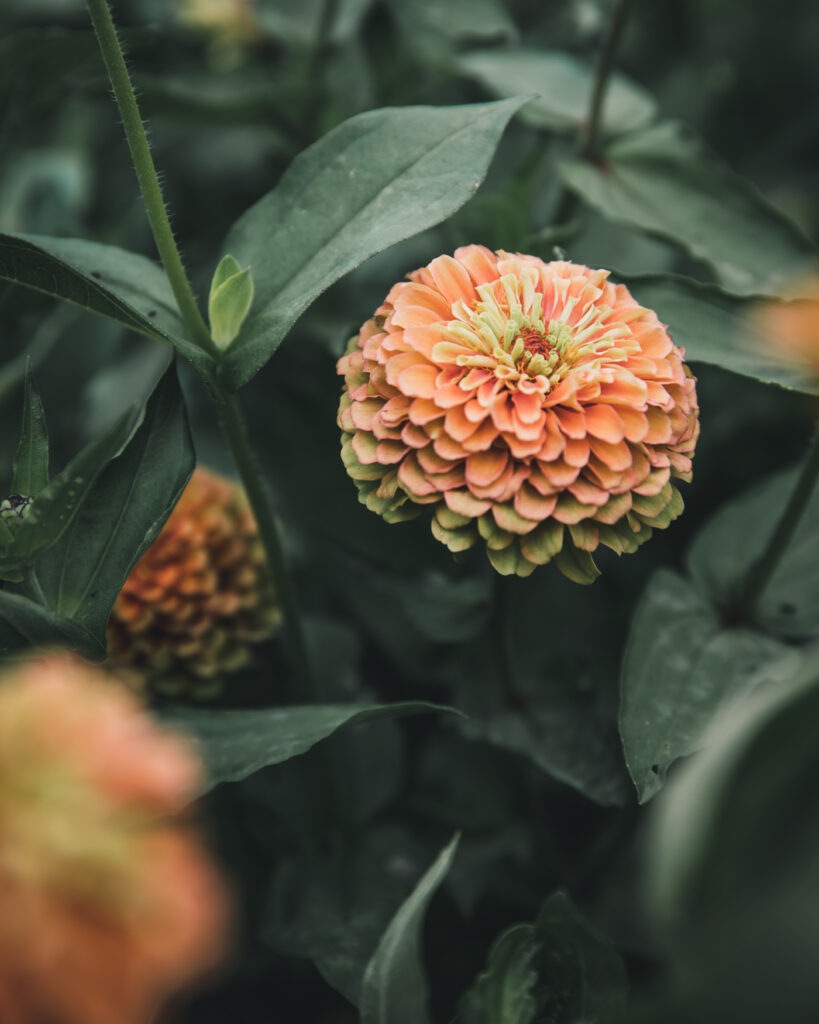
Variety Selection: BTS
I’ve grown many zinnia varieties over the years, but I’d say my favorites are Benary Giants, Queen Series, Oklahoma Series, and I’ve really liked Floret’s Unicorn zinnias.
Pricing N&B
According to USU, “Zinnias are a fairly common flower and command a modest price from florists. Zinnia sales at farmer’s markets are typically high and they are excellent additions to mixed bouquets. Wholesale price for zinnias range from 25 to 50 cents per stem depending on type and color of bloom. When selling to florists, zinnias are typically bundled in groups of ten (larger bloom types could be bundled in fives). In the Wasatch Front markets, USU trial zinnias sold for $1 per stem.”
Pricing BTS
I don’t sell a lot of zinnias to florists, but when I do I charge $0.75 / stem.
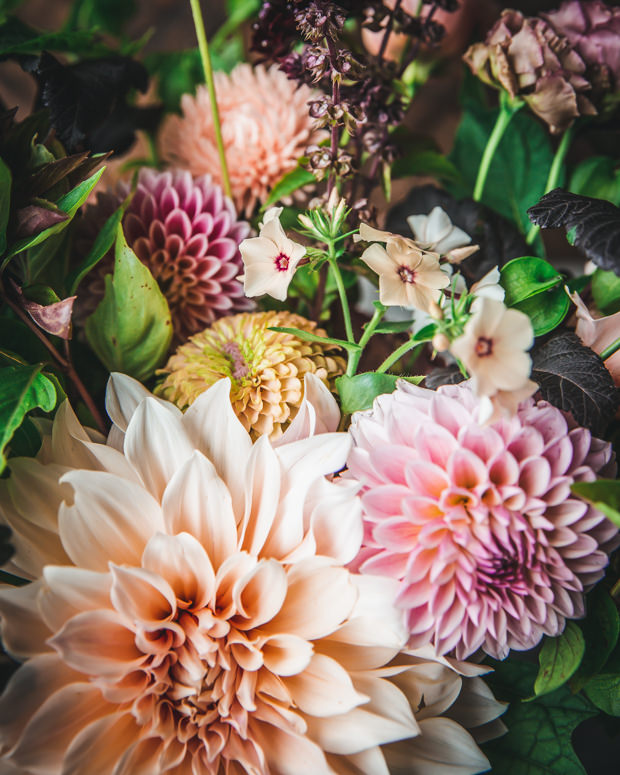
Design N&B
As noted in the beginning, my favorite use for zinnias is in design. They’re not the focal wow factor, but they are magical support flowers that can bridge colors in an arrangement together. I especially love the Queen and Oklahoma series for design. I love Queen Lime Red for moody designs. Queen Lime Orange goes well with muddy tones. I recently used them for a wedding with Roseanne Light Brown Lisianthus, Bronze Nicotiana, Amaranth Hot Biscuits and Caramel Antike roses (brought in from Grace Rose Farm).
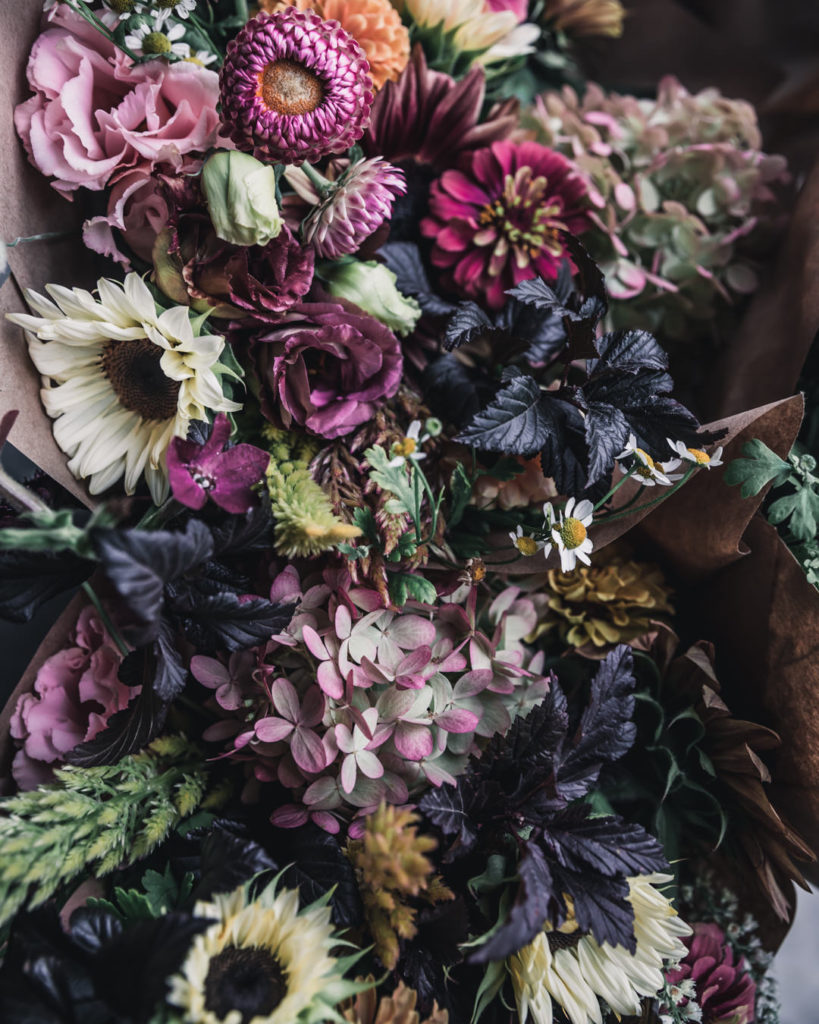
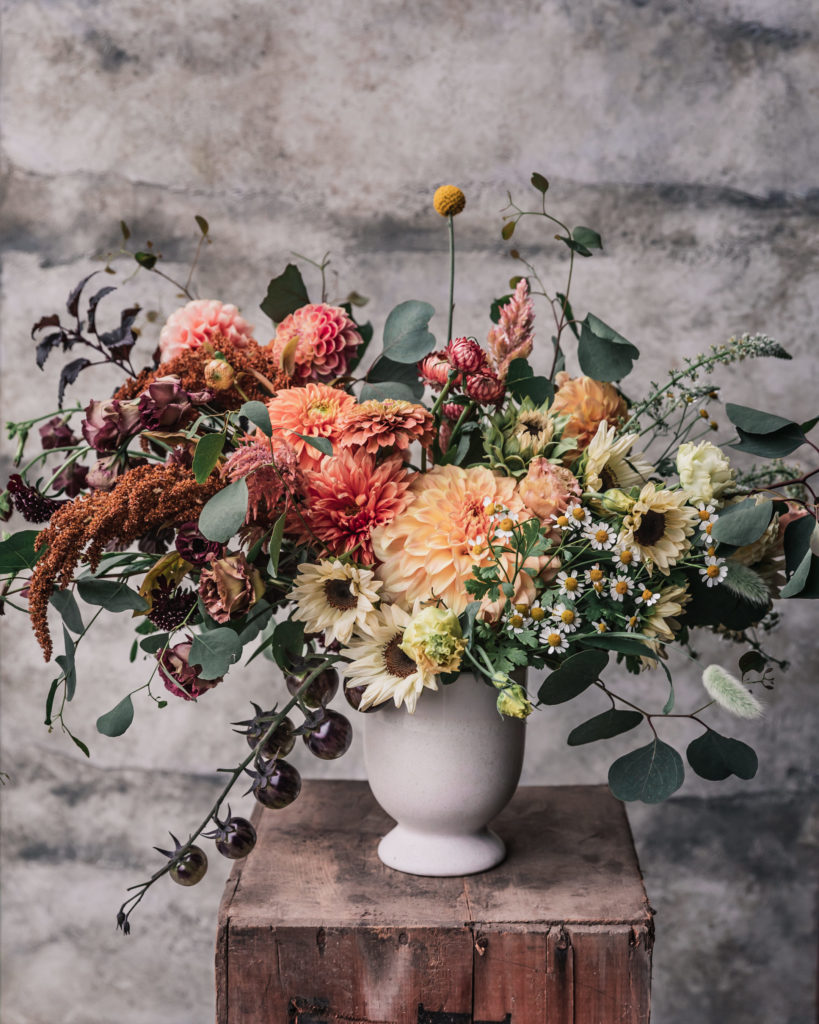
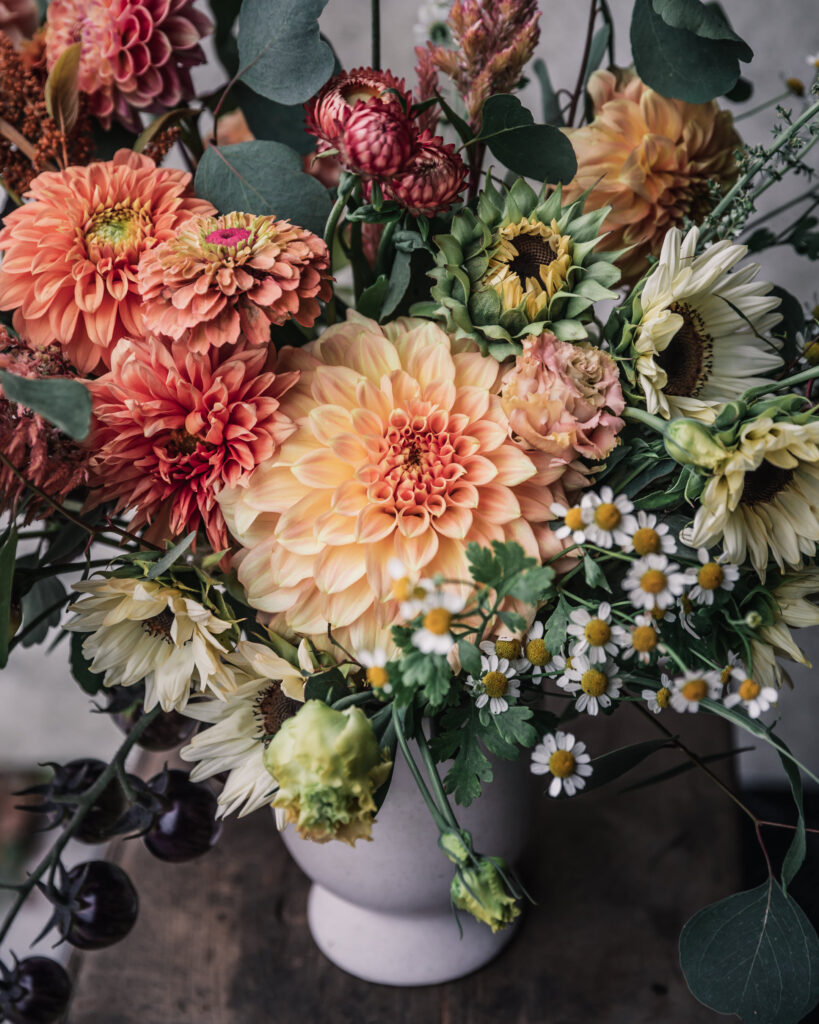
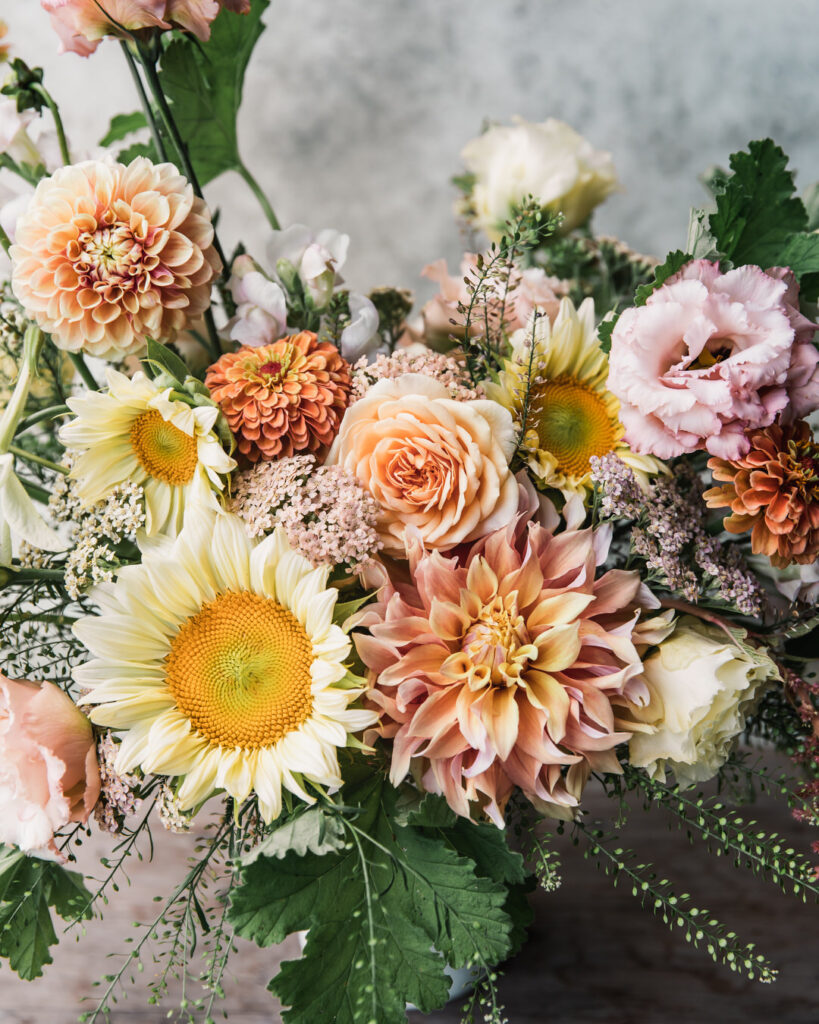
Wrap Up
OK, my friend, that is IT for August’s Plant Profile. What do you think? Did you find some useful nuggets? Is there anything that’s unclear or you wish I would have covered? Or is your head spinning? No worries, you will get a copy, so you can always refer back it. Tip: use the find shortcut (Ctrl+F on a PC or Command+F on a Mac to search for any word or term).
Have any questions or something you want to share with me or others? I know I say this ad nauseam, but I truly believe in the power of the collective and that we all have something unique and powerful to share, so please leave a question or share a comment below. We’re all better for it, and I thank you in advance!
Cheers pal!
comments +